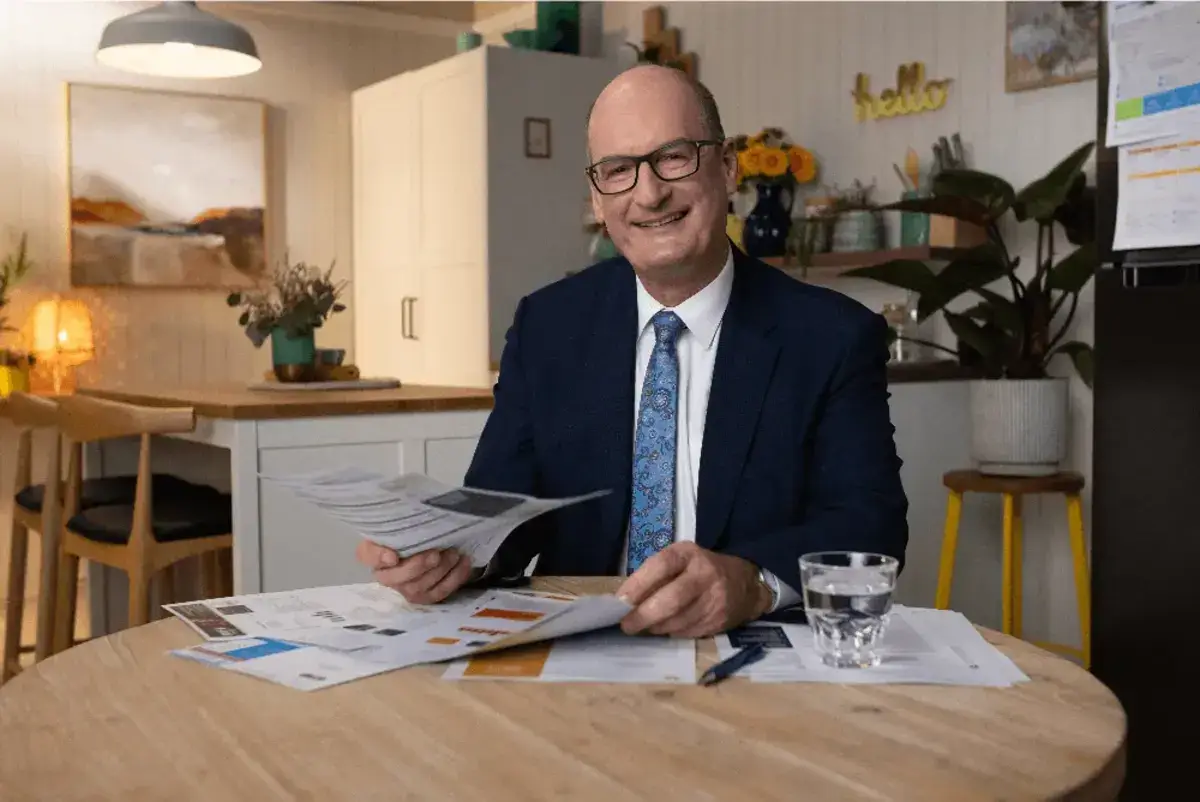
The following is David Koch’s personal views, as published in his ‘Your Money Digest’ newsletter.
Hi everyone,
RBA Board meeting week and it was steady as she goes. A change in RBA Governor from Philip Lowe to Michele Bullock made no difference at all… and I suspect that was the point.
There was all sorts of talk in the lead up to the meeting about whether Michele would stamp her own unique brand on the Board meeting and the commentary surrounding the decision. Would she be more hawkish and aggressive or more moderate?
Yeah right… as if that was going to happen. Michele Bullock has been part of the RBA Board for years and understands the role of the Central Bank is to maintain continuity and confidence in the financial system. And that is exactly what she is doing.
To the actual decision and, as expected, official interest rates were kept on hold for a fourth consecutive month at 4.1 per cent.
The Governor only made minor changes to the explanation attached to the decision, saying previous rate rises were “working to establish a more sustainable balance between supply and demand in the economy and will continue to do so.”
The RBA has noted that inflation has peaked, “but is still too high and will remain so for some time yet.” Goods price inflation continues to ease, but services price inflation is still trending higher. The RBA has also noted the recent rise in fuel prices and elevated rent inflation. It continues to reinforce that “returning inflation to target within a reasonable timeframe remains the Board’s priority.”
Inflation is currently tracking to the RBA forecasts which expects headline inflation to be back into the 2-3 per cent target range at the March-June quarter 2025.
The RBA has also highlighted that “growth in the Australian economy was a little stronger than expected over the first half of the year”. As well, “conditions in the labour market remains tight, although they have eased a little”.
The September quarter CPI figure due at the end of October is going to be absolutely critical in determining whether the RBA will lift interest rates on Melbourne Cup Day next month.
If it comes in on expectations and the trend continues down, then expect another pause and the likelihood that rates have peaked.
If it comes in higher than expectations, the RBA Board meeting on 7 November will likely raise rates another 0.25 per cent. Some analysts still see one more rate rise between now and next March.
But one thing is clear, there will be no rate cuts until the back end of next year. A few months ago some analysts were expecting rate cuts to come as soon as the March quarter next year as the economy slowed dramatically. That now looks very unlikely.
This looks to be the top (or close to) of the interest rate cycle and will be as tough as it gets. But it isn’t going to get any better anytime soon. What you see is what you get for the next year or so.
Home loans and building approvals rebound… but don’t be fooled
With the current shortage of housing, a rise in home lending and building approvals is a positive… but don’t be fooled, it’s still pretty grim.
New housing lending, excluding refinancing, rose by 2.2 per cent in August and was stronger than expected following declines in the previous two months. New housing lending for owner occupiers rose by 2.6 per cent, while investor lending increased by 1.6 per cent.
The strength in owner occupier housing lending was stronger in the purchase of existing dwellings (+2.5 per cent), while lending for new dwelling construction rose 1.4 per cent (but is still down 33.7 per cent over the year). Dwelling construction loans are 35.6 per cent lower compared to a year ago and 30 per cent below pre-pandemic levels.
These figures show the housing shortage isn’t going to ease for a while because there is just not enough new housing being financed or built.
While housing finance figures are one lead indicator on future housing supply, another is building approvals which rose 7 per cent in August following a 7.4 per cent fall in July.
Building approval is a volatile series due to large fluctuations in multi unit approvals. In August, private multi unit approvals were 9.4 per cent higher in seasonally adjusted terms, following a 14.6 fall in July. The level of multi unit approvals remains low because of higher interest rates, rising construction costs and builders going broke.
Around 50 per cent of new multi unit approvals make their way onto the rental market, so boosting apartment and townhouse approvals is especially important for rental supply in the medium term.
Approvals for private detached housing is generally much less volatile but produced a large 5.8 per cent gain in August. While the increase is a positive for housing supply, the level remains subdued at below the decade average and 15.2 per cent lower over the year.
Overall, the number of dwellings being approved in Australia remains insufficient and is well below the Federal Government’s target for the five years from July 2024 (240,000 per year). This weakness is occurring at a time of unprecedented population growth. On a per capita basis, dwelling approvals are near record lows.
What worries a chief worrier?
With all the uncertainty that’s going on at the moment, I was interested in the comments of the ANZ bank’s chief risk officer in their Blue Notes newsletter.
As Group Chief Risk Officer, Kevin Corbally is paid to worry about the biggest risks facing the bank and its clients.
According to Kevin, the vast majority of ANZ customers are in relatively good financial shape and their household finances remain robust. Stressed mortgage losses currently account for about 0.6 per cent of ANZ’s mortgage book, compared with about 1.2 per cent before the COVID pandemic. Similarly small business delinquencies are substantially lower than pre-COVID.
About 70 per cent of ANZ customers are ahead on their mortgage repayments and roughly one third are two years in advance. And offset balances are 50 per cent higher than pre-COVID. The proportion of small business customers with savings buffers of more than 12 months (58 per cent) is also much higher than before the pandemic (49 per cent).
So, while the economy is slowing and rising interest rates are squeezing household budgets, according to Kevin, the three main causes of ANZ customers defaulting on a loan are job loss, marriage breakdown or illness.
If people have confidence they have (and will keep) their job, can get a job or even get a second job, that encourages confidence to spend and confidence to make loan repayments.
So Kevin factors unemployment data into his forecasts when looking at potential future delinquencies and credit provision levels.
Australia’s unemployment rate held steady at 3.7 per cent in August, which is close to full employment. So customers are showing the confidence to continue servicing, and even getting ahead, on their loans.
That said, if unemployment goes up, it’s likely more people will become financially stressed.
Government unveils new rules for large super funds
From 1 July 2025 the Federal Government plans to reduce the tax concessions on people with more than $3 million in their superannuation fund. An extra 15 per cent tax will be added to the annual “earnings” of the fund… on top of what they already pay.
The controversy is not just the introduction of a new tax but also that is on unrealised gains in the fund, not just income earned or profits from the sale of an investment. It includes the unrealised gains on assets staying in the fund as well.
The legislation for the proposed changes was unveiled this week.
Earnings to be taxed will basically be anything other than “new money” (such as contributions) that makes the member’s superannuation balance go up. So it will cover a rise in the share or property values in the portfolio which haven’t been sold and remain in the portfolio.
If the portfolio goes down in value there are no tax refunds, instead any losses can be carried forward to offset this new tax on any future gains. But if the fund balance falls below the $3 million threshold, and the new tax doesn’t apply in the future, the offset is just wasted. That is strange.
Also the new tax only applies to earnings on the portion above $3 million, not on the whole lot. So if the fund balance is $5 million, the tax only applies to the proportional $2 million.
The immediate reaction of many people may be to sell superannuation assets and make withdrawals to get their balance down below $3 million. But it isn’t as easy as that and people should get professional tax and investment advice.
The tax consequences of selling assets and making withdrawals before July 2025 may be worse than just keeping the portfolio as is.
Thank goodness property values continue to rise
The worst nightmare for Australians coping with higher mortgage repayments would be if property prices were falling at the same time. Negative equity, where the value of a loan is more than the value of the property, is when foreclosures start as lenders get nervous.
That isn’t happening and looks unlikely.
CoreLogic’s national Home Value Index (HVI) rose 0.8 per cent in September – the eighth consecutive month of growth and up 2.2 per cent for the September quarter. The June quarter was up 3 per cent.
The September quarter saw Adelaide recording the highest capital gain at 4.3 per cent, followed by Brisbane at 3.9 per cent and Perth at 3.6 per cent. At the other end of the growth spectrum is Hobart where values were down 0.2 per cent over the quarter, a new cyclical low.
CoreLogic’s research director, Tim Lawless, noted the three capitals recording the highest capital gain each have advertised supply levels that are around 40 per cent below their previous five-year average. Advertised supply levels across Hobart, where values are still trending lower, have been holding at above average levels since June last year and were almost 40 per cent above its five-year average.
Since finding a trough in January, the national index has recovered 6.6 per cent, however home values remain 1.3 per cent below record highs recorded in April last year.
After leading the recovery cycle, the premium housing sector might be losing some steam. The quarterly rate of growth across upper quartile dwellings has eased back to 2.3 per cent while the lower quartile growth rate accelerated to 3.2 per cent.
In the more expensive cities, Sydney and Melbourne, the broad middle of the market is now recording the highest growth rate after previously being led by the upper quartile.
Driver’s change their habits to fight higher petrol prices
With petrol prices hovering well above the painful $2/litre mark in many parts of the country – and experts predicting that high prices will remain for the rest of the year – new research from Compare the Market (I’m CTM’s economic director) has revealed that almost two-thirds of people (64.4 per cent) have changed their driving habits. In fact, as many as two in five Aussies surveyed say they’re driving less due to petrol price hikes.
South Australians are seemingly feeling the pinch the most, with over two-thirds (69.4 per cent) claiming that they have changed their driving habits following the increased cost of petrol, with a similar number of Victorians and New South Welshmen making changes to their car usage.
It’s no surprise. In July, the nation-wide average for Unleaded 91 was as low as $1.67. By the end of September, it had jumped to around $2.10 a litre – a 25.7 per cent increase.
While driving less was the biggest habit change that Australians have made, a further 5.6% have switched to other modes of transport, while another 5.9% say they are working more from home to combat the price rises.
With petrol prices rising dramatically in the last few months, it’s understandable that at some point something’s just got to give. And in this case, it’s people’s driving habits that are on the chopping block.
While maybe a few months ago it was still viable for people to drive out a bit further to shop at local markets to get their produce at a cheaper price, the climbing price of petrol may no longer justify an extra 30 minutes or so in the car, forcing people to pay higher prices at closer stores.
But people shouldn’t take this hit lying down. There are ways they can still save on petrol that sometimes fade into the background, like shopping around for fuel through one of the many fuel apps out there. Compare the Market’s Simples App is free for you to use.
People may get into a rhythm of going to the servo that’s on their way home or to work, but shopping around at nearby fuel stations that may be off the main roads, could result in up to 30 cents per litre cheaper fuel depending on what’s happening with the fuel cycle near you.







